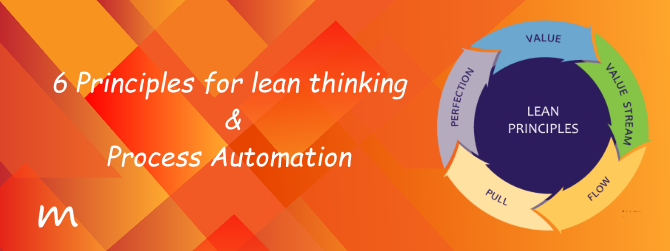
Process automation with a lean methodology aims to provide a new way to think about how to organize human activities to deliver more benefits and value to individuals while eliminating waste. Here below we discuss about 6 principles of lean thinking that can help in process automation using RPA.
1. Stay customer focused.
Customers are of different nature and they have their own priorities. Keep in mind that they know their business better than you. Ultimately, what all customers want is value. Value creation occurs when the quality and benefits of services received is perceived as high as compared to their cost. So, discuss with our customer and know their priorities. Understand their pain points. Help them overcome their pain and provide solutions based on their priorities. This makes them happy than anything else.
2. Understand how their work gets done.
We have lots of assumptions about how work gets done that don’t mirror exactly what happens. After all, during the day-to-day activities, we don’t think about how we do the work, we often just do it. Have a good process analyst to record the steps of the process in a way that he/she could repeat it, if they had to, without assistance. As for updated process maps and documentation that can help you with quick TAT. Do not forget to cover up the exception scenarios in detail and the approach to handle them.
3. Get rid of inefficiencies and waste.
Once you know what the workflow of your process looks like, take a second look at any step in the process that doesn’t directly create value for the customer. Manage, improve, and smooth your process flow to eliminate unnecessary / non-valued-added activity. Usually the additional steps are due to awareness / lack of knowledge about the whole process and the environment. Example: the user shall be using a report that he receives from another department in his email for his process. He might not have the knowledge that the same report is available on the system he uses regularly. He can easily request access to this report and start using it instead of waiting for the email which is a loss of time.
4. Measure benefits and manage by evidence.
Usually traditional measures often do not justify the deployment cost and ROI of RPA. While the organization estimates RPA deployments bring an average 20 percent to 30 percent cost savings, there’s more to measure than the just the financial impact. The benefits can be tangible and intangible
The below are some important tangible metrics to track:
Velocity – Measure the start time versus stop time of a back-office process before and after an RPA deployment and compare
Productivity – Measure the length of time human workers spent on a task versus how quickly robots complete that same task
Quality – Measure output accuracy before and after RPA deployment try to achieve 100 percent.
Compliance – Measure compliance before and after RPA deployment. Try to achieve 100 percent.
There are other intangible benefits like Improved customer experience, increased operational agility, flexible work force and more.
Collect data on how well it is working, highlight and eliminate errors, and seek continuous improvements in value. Don’t assume an improvement has been made and prepare a proof.
5. Empower the people operating the process.
The best person to improve a process is the person who carries out the process. Utilize employee’s full skill sets – can someone be doing more? If the process is improved / automated, they will likely have time to take on higher level work. The goal is to shift human effort to value adding tasks that involve interaction, judgment and interpretation. This way your employees get improved job satisfaction and new value to themselves.
6. Adapt a systematic approach of delivery.
Your processes may not be perfect and even if it is, it won’t stay that way for long. Your business demands changes to your process and it evolves over time. Being able to replicate the steps of process improvements is the key to delivering long-term, sustained value.

